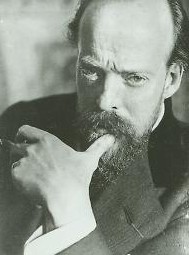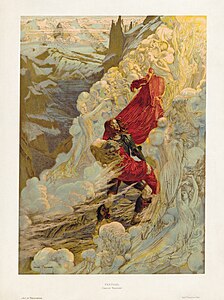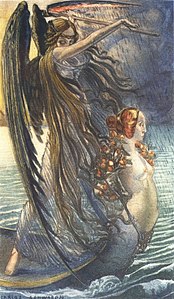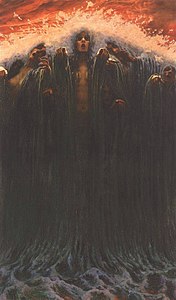Carlos Schwabe
This article includes a list of general references, but it lacks sufficient corresponding inline citations. (June 2011) |
Carlos Schwabe | |
|---|---|
 Carlos Schwabe self portrait, circa 1900 | |
| Born | Émile Martin Charles Schwabe 21 July 1866 |
| Died | 22 January 1926 (aged 59) Avon, France |
| Nationality | Swiss |
| Movement | Symbolism |
Carlos Schwabe (born Émile Martin Charles Schwabe; 21 July 1866 – 22 January 1926) was a Swiss Symbolist painter and printmaker.[1]
Life
Schwabe was born in Altona, Holstein into a merchant family. In 1870 his family moved to Switzerland, receiving Swiss citizenship in 1888. Between the years of 1882 to 1884, he studied at the École des arts industriels.
After studying art in Geneva, he relocated to Paris as a young man, where he worked as a wallpaper designer, and he became acquainted with
Schwabe's paintings typically featured mythological and allegorical themes,[1] with a very personal and idealist vision and social interest. References to the artists Albrecht Dürer and Andrea Mantegna can be seen in Schwabe's work.[2]
Schwabe is known for being one of the most important symbolist book

The most important works by Schwabe belong to the Musée d'Orsay in Paris, the Musée d'Art et d'Histoire in Geneva, the Museu Nacional de Belas Artes in Rio de Janeiro, the Van Gogh Museum in Amsterdam, the Royal Museums of Fine Arts of Belgium in Brussels and in private collections.
Schwabe lived in France for the rest of his life and died in Avon, Seine-et-Marne in 1926.
Work
Two distinct styles are recognized in Schwabe's art. Before 1900, Schwabe's paintings were more individual and experimental, indicating the idealism of the Symbolists; conventional, allegorical scenes from nature became more prominent in his later work. Images of women were important, sometimes representing death and suffering, other times creativity and guidance. His first wife was his model for angels and virgins, and "Death" in Death and the Grave Digger (1895) resembles her. The death of a close friend in 1894, the musician Guillaume Lekeu, when Schwabe was 28 years old, engendered his interest in representing death and the world of ideal creation.
Schwabe created an important watercolor that was the model of a lithographic poster for the 1892 Salon de la Rose + Croix, the first of six exhibitions organized by Joséphin Péladan that demonstrated the
Gallery
-
La douleur, 1893
-
Cloches du soir (Evening bells, 1895)
-
Death and the Gravedigger, 1895
-
Fervaal, 1898
-
Les Fleurs du mal, 1900
-
l'Ame du vin, 1900
-
Colors of Evil, 1900
-
Elysian Fields, 1903
-
Wave, 1906
-
Spleen et Idéal, 1907
-
Lotte, the artist's daughter, 1908
References
- ^ a b Bähler, Anna (10 November 2011). "Carlos Schwabe". Historisches Lexikon der Schweiz. Historisches Lexikon der Schweiz. Retrieved 22 February 2021.
- ^ Soulier, Gustave. "Artisti contemporanei: Carlos Schwabe" [Contemporary Artists: Carlos Schwabe]. Emporium (in Italian). pp. 163-197: Bergame.
{{cite magazine}}: CS1 maint: location (link)
- Jumeau-Lafond, Jean-David, (1986), Une autre lumière. Carlos Schwabe, l'idéalisme et la mort in L'Écrit-voir,n° 8.
- Jumeau-Lafond, Jean-David, (1986), Carlos Schwabe, illustrateur symboliste, Bulletin du bibliophile, n° 2.
- Jumeau-Lafond, Jean-David, (1987), Carlos Schwabe et le nouveau mysticisme, in Un symboliste genevois : Carlos Schwabe, exh. cat., Genève, musée d'Art et d'Histoire.
- Jumeau-Lafond, Jean-David, (1987), Carlos Schwabe, illustrateur symboliste du Rêve de Zola, Revue du Louvre et des musées de France, n° 5-6.
- Jumeau-Lafond, Jean-David (1988), Guillaume Lekeu et Carlos Schwabe : "Une haute confraternité artistique", Revue de musicologie, t. 74, n°1, 1988, p. 53-68.
- Jumeau-Lafond, Jean-David (1993) Révolte et folie visionnaire chez Carlos Schwabe : La Vague 1906-1907, in "L'Âme au corps", exh. cat., Paris.
- Jumeau-Lafond, Jean-David, (1994), Carlos Schwabe, symboliste et visionnaire, Paris, ACR editions.
- Jumeau-Lafond, Jean-David, (1996), Peinture, hystérie et opéra : les révoltées tragiques de Carlos Schwabe, Genava, revue du musée d'Art et d'Histoire de Genève.
- Jumeau-Lafond, Jean-David, (1999), Les Peintres de l'âme. Le symbolisme idéaliste en France, exh. cat. Bruxelles, Paris (and 2000-2004 : Salzburg, Chemnitz, Madrid, Japan : German, Spanish and Japanese translations).
- Clement, Russell T. et al. (2004). A Sourcebook of Gauguin's Symbolist Followers. Greenwood Publishing Group, 865–867. ISBN 0-313-31205-2.
- Jumeau-Lafond, Jean-David (2007), Painters of the soul, Tampere, Museum of Art.
- Greenspan, Taube G. "Schwabe, Carlos." In Grove Art Online. Oxford Art Online (accessed 26 May 2008).
- Jumeau-Lafond, Jean-David (2011) Séailles mécène : Schwabe, la conscience et l'exemple, introduction to : Gabriel Séailles, "Carlos Schwab" (1914, in Le Génie dans l'art, anthologie des écrits esthétiques et critiques de Gabriel Séailles, Sarah Lindford and Michela Passini, Paris, Kimé 2011.
- Jumeau-Lafond, Jean-David (2017) "Carlos Schwabe" in "Mystical Symbolism. The Salons de la Rose+Croix 1892-1897", exh. cat. ,New York, Solomon Guggenheim Museum.
External links
 Media related to Carlos Schwabe at Wikimedia Commons
Media related to Carlos Schwabe at Wikimedia Commons











